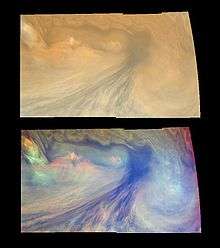Jovian Infrared Auroral Mapper

Jovian Infrared Auroral Mapper (JIRAM) is an instrument on the Juno spacecraft in orbit of the planet Jupiter. It is an image spectrometer and was contributed by Italy.[1] Similar instruments are on ESA Rosetta, Venus Express, and Cassini-Huygens missions.[1] The primary goal of JIRAM is to probe the upper layers of Jupiter's atmosphere down to pressures of 5–7 bars (72–102 pound/square inch) at infrared wavelengths in the 2–5 μm interval using an imager and a spectrometer.[1] Jupiter's "hot spots" and auroral regions are targeted for study.[2]
It is hoped H+
3 ions, ammonia, and phosphine can be mapped.[3] The ion of Hydrogen H+
3 is rare on Earth, but is one of the most common ions in the universe and known as protonated molecular hydrogen or the trihydrogen cation.[4]
Despite the intense magnetosphere of Jupiter, the JIRAM is expected to be operational for at least the first eight orbits.[5]
References
- 1 2 3 "Juno - Spacecraft: Instruments - JIRAM". Juno.wisc.edu. 2008-10-23. Retrieved 2016-02-17.
- ↑ "JIRAM, the image spectrometer in the near infrared on board the Juno mission to Jupiter. - PubMed - NCBI". Ncbi.nlm.nih.gov. 2015-09-28. Retrieved 2016-02-17.
- ↑ P. Irwin (2009). "Giant Planets of Our Solar System: Atmospheres, Composition, and Structure". Books.google.com. p. 352.
- ↑ Carrington, Alan; R. McNab, Iain (1989). "The infrared predissociation spectrum of triatomic hydrogen cation (H3+)". Accounts of Chemical Research. 22 (6): 218–222. doi:10.1021/ar00162a004.
- ↑ "Understanding Juno's Orbit: An Interview with NASA's Scott Bolton". Universe Today. Retrieved 6 February 2016.
External links
- Juno JIRAM website
- Jovian InfraRed Auroral Mapper - Lunar and Planetary Institute
- Juno instruments (Adobe Flash)